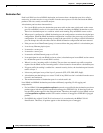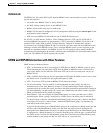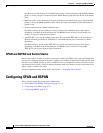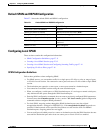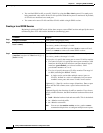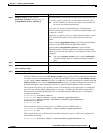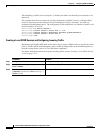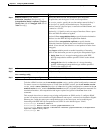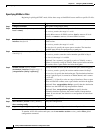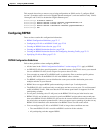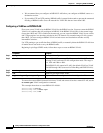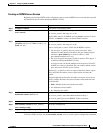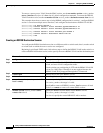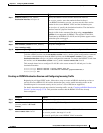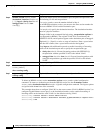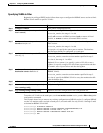
27-16
Catalyst 2960 and 2960-S Switch Software Configuration Guide
OL-8603-09
Chapter 27 Configuring SPAN and RSPAN
Configuring SPAN and RSPAN
Specifying VLANs to Filter
Beginning in privileged EXEC mode, follow these steps to limit SPAN source traffic to specific VLANs:
To monitor all VLANs on the trunk port, use the no monitor session session_number filter global
configuration command.
Command Purpose
Step 1
configure terminal Enter global configuration mode.
Step 2
no monitor session {session_number | all |
local | remote}
Remove any existing SPAN configuration for the session.
For session_number, the range is 1 to 66.
Specify all to remove all SPAN sessions, local to remove all local
sessions, or remote to remove all remote SPAN sessions.
Step 3
monitor session session_number source
interface interface-id
Specify the characteristics of the source port (monitored port) and
SPAN session.
For session_number, the range is 1 to 66.
For interface-id, specify the source port to monitor. The interface
specified must already be configured as a trunk port.
Step 4
monitor session session_number filter vlan
vlan-id [, | -]
Limit the SPAN source traffic to specific VLANs.
For session_number, enter the session number specified in Step 3.
For vlan-id, the range is 1 to 4094.
(Optional) Use a comma (,) to specify a series of VLANs, or use a
hyphen (-) to specify a range of VLANs. Enter a space before and after
the comma; enter a space before and after the hyphen.
Step 5
monitor session session_number
destination {interface interface-id [, | -]
[encapsulation {dot1q | replicate}]}
Specify the SPAN session and the destination port (monitoring port).
For session_number, specify the session number entered in Step 3.
For interface-id, specify the destination port. The destination interface
must be a physical port; it cannot be an EtherChannel, and it cannot
be a VLAN.
(Optional) [, | -] Specify a series or range of interfaces. Enter a space
before and after the comma; enter a space before and after the hyphen.
(Optional) Enter encapsulation dot1q to specify that the destination
interface uses the IEEE 802.1Q encapsulation method.
(Optional) Enter encapsulation replicate to specify that the
destination interface replicates the source interface encapsulation
method. If not selected, the default is to send packets in native form
(untagged).
Step 6
end Return to privileged EXEC mode.
Step 7
show monitor [session session_number]
show running-config
Verify the configuration.
Step 8
copy running-config startup-config (Optional) Save the configuration in the configuration file.



